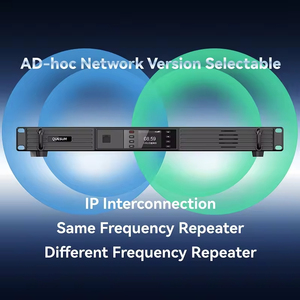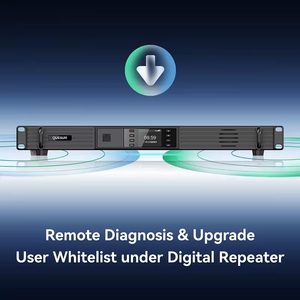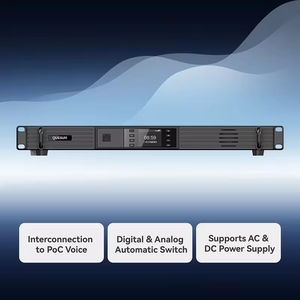(1093 products available)
































































































































































































The purpose of radio trunking is to improve efficiency when using many frequencies. These are some of the main types of radio trunking systems.
Conventional trunking systems:
These systems can be used independently or in conjunction with conventional radio communication systems. They use a control channel to establish a communication link between users and switch to the appropriate working channel for the conversation. Conventional trunking is widely used because it is cost-effective and simple.
Digital trunking systems:
Digital systems use digital signal processing trunking to encode, compress, and process voice and data signals. This enhances the clarity and quality of the transmission. Digital systems also support advanced features such as encryption, error correction, and data services. They are commonly used in situations where clear communication and data transmission are necessary, such as emergency services, public safety, and business communications.
Analog trunking systems:
These systems are based on analog technology to perform voice and signal processing. It modulates audio signals onto radio frequency carriers. This technology is widely used in various radio communications, including public address systems and two-way radio communication.
Trunked radio systems (TRS):
TRS is a two-way radio communication system that allows users to communicate over a shared radio frequency channel. This type of radio trunking uses a control channel to manage and assign voice and data transmission channels among users. It enables users to communicate efficiently and quickly over a limited number of radio frequencies.
Time division trunking systems (TDM):
TDM systems divide time into discrete time slots for communication. Each time slot is assigned to a specific user or communication session. This allows multiple users to share the same frequency channel without interference. TDM is commonly used in digital trunking systems.
Frequency division trunking systems (FDM):
FDM systems divide the available frequency spectrum into smaller sub-bands. Each sub-band is allocated to a specific communication channel or user. This allows multiple users to communicate simultaneously over different frequency channels.
Packet trunking systems:
These systems use data packets to transmit information. Each packet contains a portion of the voice or data being communicated. Packet trunking is efficient and can handle various types of information, making it suitable for voice and data services.
Trunked land mobile radio (TLRM):
TLRM refers to a type of trunked radio system specifically designed for land mobile applications. It is used by mobile radio users on land. TLRMs provide efficient and effective communication for mobile users in various sectors, including public safety, transportation, and logistics.
System Architecture:
The architecture of a radio trunking system is hierarchical and can be divided into three primary components: the core network, the trunking control, and the base stations. The core network acts as the backbone of the system, facilitating communication between different trunking groups. The trunking control manages group communications, ensuring messages are delivered efficiently. Base stations serve as the radio frequency transmission points for mobile units.
Radio Frequency (RF) Design:
RF design is critical in radio trunking systems, as it determines the operational frequency bands and their corresponding characteristics. The RF design team must ensure compliance with regulatory standards for frequency allocation, which typically involves selecting VHF, UHF, or microwave bands for different applications. Additionally, the RF design team must consider issues such as signal propagation, interference mitigation, and coverage optimization.
Channel Assignment:
Radio trunking systems use a channel assignment algorithm to assign communication channels dynamically among users. This algorithm can be either fixed or adaptive, depending on the system requirements. Fixed channel assignment assigns specific channels to certain users, while adaptive channel assignment dynamically allocates channels based on demand.
Control Protocols:
Control protocols govern the signaling and control messages exchanged between different components of the radio trunking system. These protocols are responsible for managing call setup, teardown, and handover procedures. Various control protocols can be used in radio trunking systems, including Signaling System 7 (SS7), Mobile Application Part (MAP), and Radio Frequency Interface Protocol (RFIP).
Data Management:
Data management is crucial in radio trunking systems, as it ensures efficient storage, retrieval, and processing of data. A database management system (DBMS) is typically used to manage data in radio trunking systems. This DBMS provides a structured framework for organizing and accessing data, allowing for efficient data manipulation and retrieval.
User Interface Design:
User interface design is critical in radio trunking systems, as it determines how users interact with the system. A well-designed user interface can significantly improve the usability and efficiency of the system, enhancing user experience. The user interface design team must consider various factors, such as user requirements, workflow analysis, and usability testing.
The following scenarios show how effective and beneficial radio trunking systems can be in different industries requiring reliable and instant communication networks.
Emergency response team
The emergency response team needs to communicate immediately while responding to emergencies. During an emergency, the team needs to talk to each other and communicate with other departments or agencies, such as hospitals, police, and firefighters. With radio trunking, emergency personnel can communicate seamlessly within their groups and with other departments. Also, because many users can communicate at once, emergency response can be coordinated efficiently.
Public transportation system
In a public transportation system, radio trunking can be used to improve communication among different transportation modes, such as buses, trains, and taxis. For instance, bus drivers can communicate with train operators to ensure smooth transfer at bus-train interchanges. Additionally, passengers can receive real-time updates on delays or changes in schedules through announcements made over the trunked radio system.
Construction industry
In large construction sites where multiple projects are being carried out simultaneously, workers need to communicate with each other about safety issues, project updates, material deliveries, etc. Using radio trunking systems enables different workgroups, such as electrical crews, plumbing teams, and excavation workers, to have separate channels for their specific needs while still allowing intergroup communications when necessary. This ensures that all messages are delivered without delay or interference, thereby enhancing overall site safety and productivity.
Mining operations
Mining companies operating in remote areas require reliable communication systems for coordinating activities between surface and underground crews. Radio trunking allows mine supervisors to give instructions to workers about blasting schedules, equipment failures, or emergency situations like cave-ins. Moreover, since radio signals can be easily affected by geographical features, trunking systems can help overcome this challenge through better frequency reuse and coverage optimization.
Business buyers should consider these factors when selecting a radio trunking system.
Understand Business Needs:
Identify the business's communication needs. Determine the number of users, communication patterns, and required coverage area. Consider whether voice communication suffices or if data services are necessary. For example, a large logistics company may need to track shipments in real time using radio trunking systems.
Evaluate System Capacity:
Choose a radio trunking system that can accommodate the current and future user base. Systems are available in small scale, medium scale, and large scale capacities. A medium-scale system may suit a growing municipal services company, while a large-scale system may be necessary for a national transportation firm.
Coverage and Range:
Ensure the radio trunking system provides adequate coverage for the business's operational area. Consider factors such as geographical terrain, building density, and potential dead zones. A mining company operating in remote areas would need a system with extended coverage and long-range capabilities.
Interoperability:
Check if the radio trunking system can integrate with existing communication infrastructure and other systems used by the business. Seamless integration reduces implementation costs and ensures smooth communication. For example, a security agency may require a system that integrates with its video surveillance and alarm systems.
Scalability:
Select a scalable radio trunking system that can easily accommodate future expansion requirements. As the business grows, adding new users and features should be straightforward. A franchise business model would benefit from a system designed for multiple locations and easy interconnectivity.
Data Services and Applications:
Investigate the data services and applications supported by the radio trunking system. Look for features such as location tracking, status messaging, and emergency notification systems. A public safety organization would require a system with robust data services to enhance emergency response capabilities.
Reliability and Performance:
Choose a radio trunking system known for its reliability and performance. Research the vendor's reputation and customer reviews. Consider factors such as call quality, system uptime, and coverage reliability. A healthcare provider needs a dependable system for critical patient care communications.
Cost Considerations:
Evaluate the total cost of ownership (TCO) of the radio trunking system. Consider upfront costs, maintenance expenses, and potential future upgrades. Compare costs with the features and benefits offered. A government agency may have a budget constraint and require a cost-effective solution.
Regulatory Compliance:
Ensure the selected radio trunking system complies with relevant industry regulations and standards. Verify that it adheres to licensing requirements set by the telecommunications authority. A construction company must follow safety standards for communication systems used on job sites.
By considering these factors, business buyers can choose the right radio trunking system that meets their communication needs, enhances operational efficiency, and supports future growth.
Q1. What is the difference between trunking and convention communication systems?
A1. The former allows multiple users to communicate simultaneously via different channels, while the latter permits only one user at a time until the conversation is over.
Q2. What are the benefits of using a radio trunking system?
A2. They enhance communication efficiency, optimize bandwidth usage, improve call quality, increase coverage area, and offer scalability and flexibility.
Q3. What industries use radio trunking systems?
A3. They are used in public safety, transportation, utilities, construction, and hospitality, among others, that require reliable and efficient communication.
Q4. What is the future of radio trunking systems?
A4. The future will see advances in digital trunked radio systems, integration with broadband networks, and the adoption of artificial intelligence to improve communication capabilities.
Q5. What factors should be considered when choosing a radio trunking system?
A5. The coverage area, number of users, interoperability, scalability, and budget, among others, should be considered when choosing a radio trunking system.
The web search volume for the keyword "radio trunking" in the consumer electronics category shows a notable average monthly web search volume of 1000, with significant fluctuations over the past year. The data indicates a substantial three-month change of 30% and an even more impressive one-year change of 48%. Over the last twelve months, the web search volume peaked at 1300 web searches during February, March, and November, while it dipped to 880 web searches in January and July.
Analyzing the trend in more detail, "radio trunking" experienced its highest web search volumes in the early spring and late autumn months. The peaks in February, March, and November suggest a seasonal interest, possibly linked to specific events or market releases in the consumer electronics sector that coincide with these months. Conversely, the noticeable dips in January and July could indicate a temporary decline in user interest or market saturation.
The fluctuations in web search volume for "radio trunking" over the past year reflect varying levels of consumer interest and market dynamics. The peaks and valleys in the monthly web searches highlight periods of heightened activity and subsequent declines, which could be influenced by product launches, technological advancements, or changes in consumer behavior within the consumer electronics market.